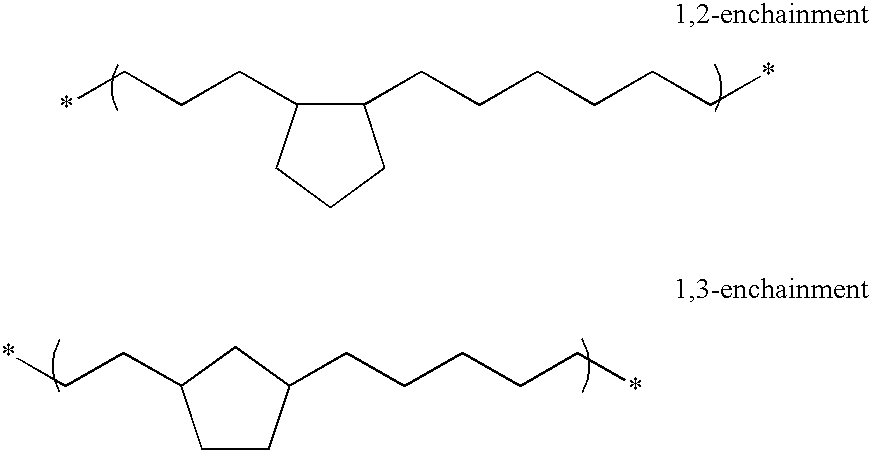Ethylene-C4-C20-alkene copolymers
a technology of alkene and copolymer, applied in the field of ethylenec4c20alkene copolymer, can solve the problems of difficult molds, high cost, and inability to meet the requirements of high thermal stability, and achieve the effects of easy formation, high thermal stability, and good wear resistan
- Summary
- Abstract
- Description
- Claims
- Application Information
AI Technical Summary
Benefits of technology
Problems solved by technology
Method used
Image
Examples
first embodiment
[0017] Copolymers of the first embodiment differ from those disclosed in Natta, G., et al, Makromol. Chem 54, 95-101 (1962) at least in the polydispersity limitation.
second embodiment
[0018] We turn now to the invention herein.
[0019] The monocyclic alkenes can be, for example, any of those named in the description of the first embodiment. Copolymers of ethylene and cyclopentene of the second embodiment were made using the conditions of said Table 1, but with less cyclopentene. Samples made in this way and their properties are set forth in the table below where CP means cyclopentene, Tm means melting temperature (differential scanning calorimeter run at 10° C. / min with the melting points reported being for the second heating run), Mn being number average molecular weight and PDI meaning polydispersity.
TABLESamplemol % CPTm(° C.)Mn (g / mol)PDI10.8125.1791k1.7521.7123.9418k1.6533.0114.6987k1.32
third embodiment
[0020] We turn now to the invention herein.
[0021] Copolymer of the third embodiment can be made as described in Fujita, M., et al, Macromolecules 35, 9640-9647 (2002) by ring opening metathesis polymerization of cicyclo [3.2.0] hept-6-ene using 2,6-diisopropylphenylimedoneophylidene [rac-BIPHEN] molybdenum VI, which is available from Strem. The catalyst complex in CH2Cl2 (1 mL) is added to monomer (M) solution and reaction is carried out using 8.5 micromol catalyst (C) and [M] / [C] ratio of 450 and 1 minute time. The resulting polymer (0.20-0.25 g) is dissolved in toluene with 4 to 5 g of p-toluene sulfonhydrazide and 0.05 g 2,6-di-tert-butyl-p-cresol and after refluxing for 9 hours, the reaction provided isotactic perfectly alternating copolymer of ethylene and cyclopentene having a number average molecular weight of 211,000 g / mol, a polydispersity of 1.55 and Tg of 17.0° C. and Tm of 181.6° C. as determined by 13C NMR. The copolymer contains no 1,3-units of cyclopentene, i.e., only...
PUM
| Property | Measurement | Unit |
|---|---|---|
| molecular weight distribution | aaaaa | aaaaa |
| polydispersity | aaaaa | aaaaa |
| polydispersities | aaaaa | aaaaa |
Abstract
Description
Claims
Application Information
 Login to View More
Login to View More - R&D
- Intellectual Property
- Life Sciences
- Materials
- Tech Scout
- Unparalleled Data Quality
- Higher Quality Content
- 60% Fewer Hallucinations
Browse by: Latest US Patents, China's latest patents, Technical Efficacy Thesaurus, Application Domain, Technology Topic, Popular Technical Reports.
© 2025 PatSnap. All rights reserved.Legal|Privacy policy|Modern Slavery Act Transparency Statement|Sitemap|About US| Contact US: help@patsnap.com

